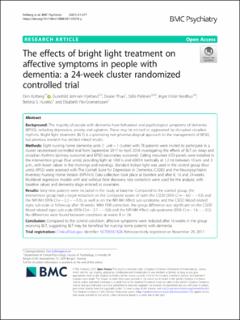| dc.contributor.author | Kolberg, Eirin | |
| dc.contributor.author | Hjetland, Gunnhild Johnsen | |
| dc.contributor.author | Thun, Eirunn | |
| dc.contributor.author | Pallesen, Ståle | |
| dc.contributor.author | Nordhus, Inger Hilde | |
| dc.contributor.author | Husebø, Bettina | |
| dc.contributor.author | Flo-Groeneboom, Elisabeth | |
| dc.date.accessioned | 2022-01-24T13:22:01Z | |
| dc.date.available | 2022-01-24T13:22:01Z | |
| dc.date.created | 2021-08-07T15:07:49Z | |
| dc.date.issued | 2021 | |
| dc.identifier.issn | 1471-244X | |
| dc.identifier.uri | https://hdl.handle.net/11250/2838977 | |
| dc.description.abstract | Background: The majority of people with dementia have behavioral and psychological symptoms of dementia (BPSD), including depression, anxiety and agitation. These may be elicited or aggravated by disrupted circadian rhythms. Bright light treatment (BLT) is a promising non-pharmacological approach to the management of BPSD, but previous research has yielded mixed results.
Methods: Eight nursing home dementia units (1 unit = 1 cluster) with 78 patients were invited to participate in a cluster randomized controlled trial from September 2017 to April 2018 investigating the effects of BLT on sleep and circadian rhythms (primary outcome) and BPSD (secondary outcome). Ceiling mounted LED-panels were installed in the intervention group (four units), providing light at 1000 lx and 6000 K (vertically at 1.2 m) between 10 a.m. and 3 p.m., with lower values in the mornings and evenings. Standard indoor light was used in the control group (four units). BPSD were assessed with The Cornell Scale for Depression in Dementia (CSDD) and the Neuropsychiatric Inventory Nursing Home Version (NPI-NH). Data collection took place at baseline and after 8, 16 and 24 weeks. Multilevel regression models with and without false discovery rate correction were used for the analysis, with baseline values and dementia stage entered as covariates.
Results: Sixty-nine patients were included in the study at baseline. Compared to the control group, the intervention group had a larger reduction on the composite scores of both the CSDD (95% CI = − 6.0 – − 0.3) and the NPI-NH (95% CI = − 2.2 – − 0.1), as well as on the NPI-NH Affect sub-syndrome, and the CSDD Mood related signs sub-scale at follow-up after 16 weeks. With FDR correction, the group difference was significant on the CSDD Mood related signs sub-scale (95% CI = − 2.7 – − 0.8) and the NPI-NH Affect sub-syndrome (95% CI = − 1.6 – − 0.2). No differences were found between conditions at weeks 8 or 24.
Conclusion: Compared to the control condition, affective symptoms were reduced after 16 weeks in the group receiving BLT, suggesting BLT may be beneficial for nursing home patients with dementia. | en_US |
| dc.language.iso | eng | en_US |
| dc.publisher | BMC | en_US |
| dc.rights | Navngivelse 4.0 Internasjonal | * |
| dc.rights.uri | http://creativecommons.org/licenses/by/4.0/deed.no | * |
| dc.title | The effects of bright light treatment on affective symptoms in people with dementia: a 24-week cluster randomized controlled trial | en_US |
| dc.type | Journal article | en_US |
| dc.type | Peer reviewed | en_US |
| dc.description.version | publishedVersion | en_US |
| dc.rights.holder | Copyright 2021 The Author(s) | en_US |
| dc.source.articlenumber | 377 | en_US |
| cristin.ispublished | true | |
| cristin.fulltext | original | |
| cristin.qualitycode | 2 | |
| dc.identifier.doi | 10.1186/s12888-021-03376-y | |
| dc.identifier.cristin | 1924542 | |
| dc.source.journal | BMC Psychiatry | en_US |
| dc.identifier.citation | BMC Psychiatry. 2021, 21, 377. | en_US |
| dc.source.volume | 21 | en_US |

